Intel Patents 'Software Defined Supercore' to Boost CPU Single-Thread Performance
Intel Patents 'Software Defined Supercore' to Boost CPU Single-Thread Performance

Intel has filed a patent for an innovative technology called Software Defined Supercore (SDC), aiming to significantly improve single-thread performance by virtually fusing multiple CPU cores into one high-performance “super core.” This technique promises to deliver higher instructions per clock (IPC) without the power and complexity costs of building ultra-wide monolithic cores.
How Software Defined Supercore Works
The key idea behind SDC is to combine the power of two or more physical CPU cores by splitting a single thread’s instructions into smaller blocks and executing them in parallel on adjacent cores. Specialized synchronization hardware and data transfer protocols ensure instructions retire in the proper program order, maintaining correctness while boosting throughput.
Each participating core runs a distinct segment of the same program, while a small dedicated hardware module handles synchronization, register transfers, and memory ordering. A reserved memory space called the “wormhole address space” aids in coordinating data and instruction flow within the supercore setup.
Advantages Over Traditional Designs
Typical x86 cores can decode 4–6 instructions and execute 8–9 micro-ops per cycle, limited by front-end bottlenecks. Building ultra-wide cores (e.g., 8-way) is expensive, inefficient, and power-hungry, with diminishing returns on IPC for significantly higher transistor counts and thermal budgets.
SDC offers a clever alternative by letting normal-sized cores work cooperatively, dynamically forming a virtual supercore when the software workload benefits from it. This allows higher single-threaded throughput through parallelization without increasing clock speed or individual core width, potentially lowering power consumption.
Software and OS Support
For SDC to succeed, operating systems and compilers must support it by splitting code segments and injecting special instructions for flow control and register passing. The OS dynamically decides when to enable or disable supercore mode based on workload and system demands, balancing performance and core availability.
Potential Impact and Challenges
If implemented successfully, Software Defined Supercore technology could represent a significant step forward for Intel in competing with architectures that offer high single-thread performance, such as Apple’s Arm-based cores.
However, the approach requires seamless integration with software and operating system schedulers, as well as minimal overhead for synchronization. Past attempts at similar multi-core single-thread solutions faced challenges due to compiler complexity and runtime instability, so Intel’s solution must overcome these hurdles to become practical.
Conclusion
Intel’s Software Defined Supercore patent suggests a novel path forward for CPU performance optimization—leveraging multiple cores as a unified, efficient execution engine. While this concept is still in the patent phase and may take years before commercial appearance, it offers an exciting glimpse into future processor designs aimed at maximizing single-thread performance without the power penalties of larger core designs.
As software and hardware evolve to complement each other, innovations like SDC could redefine how CPUs achieve peak performance in demanding applications.
